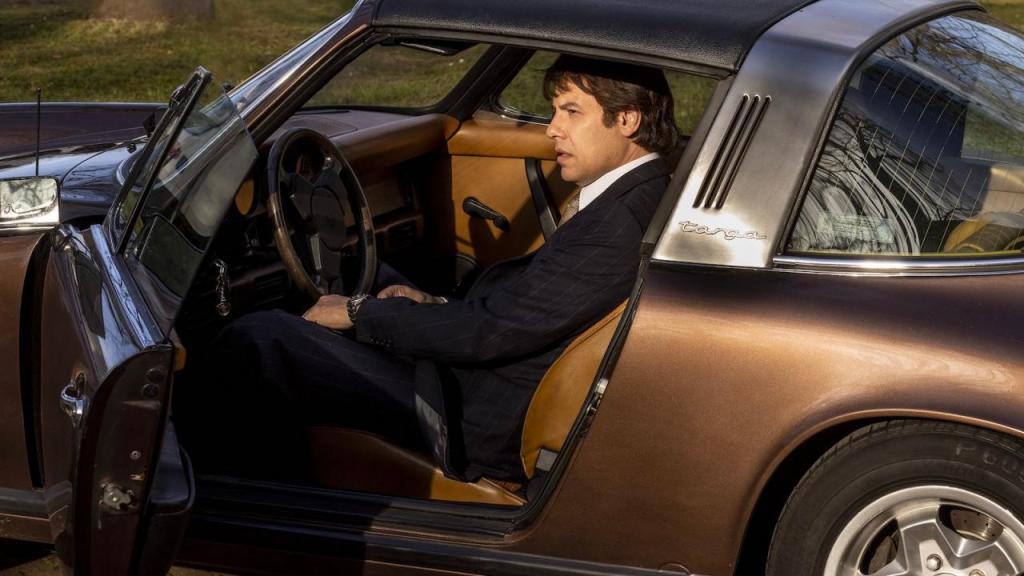A flamboyant man who was once a sales clerk, singer, actor, sports impresario, business mogul and government minister, Bernard Tapie led a rollercoaster life wilder than most fictional characters depicted in pop culture, even those created by Martin Scorsese.
No wonder that it took a decade for Tristan Seguela (“A Good Doctor”) and Olivier Demangel (“November”) to create and pen “Tapie,” a Netflix original series charting the swaggering man’s epic rise, from his blue-collar origins to his glorious days as a wealthy businessman and president of one of France’s biggest soccer clubs, Olympique de Marseille. The limited series tells intimate parts of his life, including his relationship with loved ones and business partners, as well as some of his setbacks and legal problems. Tapie died in 2021.
The first two episodes of “Tapie” world premiered at Canneseries TV festival and were warmly received with a standing ovation. Based on the talent involved and glossy production values, “Tapie” probably marks one of Netflix’s biggest investments for a French original series. It’s not the easier project either, considering Tapie’s controversial profile and the fact that hardly anyone outside of France has ever heard him. But the show’s biggest selling point is the fact that it tells a real and colorful rags-to-riches story, and there’s a global audience for that.
The series’ appeal lies, among other things, in the committed performance of Laurent Lafitte, an actor trained at the Comédie Française, who plays the title role with the panache, aplomb and irrepressible charm that characterized Tapie.
In an interview with Variety, Lafitte said the idea for the project came a decade prior when he was starring in Seguela’s first film, “16 ans ou Presque.” “I was in my dressing room with a wig on and Tristan told me, ‘it’s funny, you look like Bernard Tapie!’ and I told him, ‘Yes, and he’s a character I would love to play,’ and he answered ‘It’s a story I would love to tell” — and we never forgot this idea all these years,” said Lafitte, whose credits include Paul Verhoeven’s “Elle” and Louis Leterrier’s “On The Other Side of the Tracks.”
The actor described Tapie as a character that could have been created by Alexandre Dumas, and one that triggered ambivalent feelings in people, ranging “from attraction to repulsion and fascination and sometimes even hatred.” “I feel that he embodied contradictions that are very French with an ambition that was very Anglo-Saxon; he was the first French tycoon, a real self-made man who had this rage within him and wanted to turn his name into a brand,” said Lafitte, who added that he was also interested in Tapie’s artistic frustrations and his thirst for recognition.
One of challenges for his role was to convey Tapie’s humanity even when we see him deceiving others to get what he wants. Lafitte pulled it off “without falling into a caricature” or “staying in character,” he said. “It’s not a performance where we don’t recognize the actor at all. I wanted this to be my version of Tapie so I had to find a balance in terms of the resemblance, gesture, way of speaking and voice,” he continued.
Demangel and Seguela, who directed the series, said some of the references for “Tapie” was Scorsese’s “The Wolf of Wall Street” and “Raging Bull.”
“‘The Wolf of Wall Street’ inspired us a lot in terms of the tone of dialogue, the construction of the narration, and the pace. We also watched ‘Raging Bull’ many times when we started writing,” said Demangel, who co-wrote the series with Seguela. “There was some ‘Raging Bull’ in Tapie and in the way he would bounce back on the ring, driven by both his megalomania and his passion. He falls a hundred times, and he gets back up every time,” Demangel continued.
Seguela said Tapie was a “very French incarnation of the American dream” who “surfed on the wave of the American self-made men like Trump who were showcasing themselves on TV in the 1980’s.” But in France, this type of attitude ruffled feathers even if it sparked some fascination, he argued.
“At the end of the 1970s and early 1980s, as France was entering a recession, seeing a guy who was coming from nowhere and said you could make it if you believed in yourself inspired a lot of people to launch their own businesses,” said Demangel.
The pair did some “real investigative work,” and read “countless biographies, articles and all sorts of publications and we made discoveries,” Seguela explained. “Tapie was a legend and what we did was take a deep dive into this legend which we was formidably documented, at least as much as Johnny Hallyday,” Seguela said, citing the impressive number of references found within the database of the National Institute of Audiovisual (INA). “In the 1980s and 1990s, Tapie was omnipresent in the media landscape,” added Demangel.
Ultimately, Seguela said the idea was to draw a portrayal that would be bare of moral considerations. “We wanted to deliver an intimate portrayal of the character and try to understand what drove him deep inside,” said Seguela, whose father Jacques Séguéla was a close friend of Tapie’s and who admired him when he was a teenager because he owned Adidas and the Olympique de Marseille.
Tapie had a “visceral attachment to his roots his whole life (…) whereas many people who climb the social ladder tend to turn their backs on their native language or their origins, but that wasn’t him,” Seguela said.
“Tapie” was produced by Bruno Nahon at Unité. The stellar ensemble cast includes Josephine Japy, who plays Tapie’s long-time spouse Dominique, along with with Camille Chamoux, Fabrice Luchini, Hakim Jemili and Antoine Reinartz. The key crew includes cinematographers Hichame Alaouie (“Mothers’ Instinct”) and Romain Carcanade (“The Swarm”).
Read More About:
Source: Read Full Article


